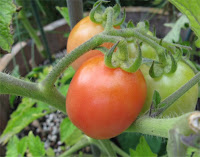
and now I think we're done. Except for the black radish - that is growing delicious greens - and the beets still fattening in their pots, and the kale (Red Russian and the one Black Kale plant that was spared by whatever has eaten the rest to sticks) and a few leeks and some celery.
The tomatoes are just about over as well - most of the ones I picked green are now ripe and ready to cook into something more durable: passato is one idea I have.
Meanwhile, the leaves fall and I've got them mostly chewed up and on the beds as winter mulch. Time to spend the winter learning more about growing.
To which end I happened to make it to Robin Tunnicliffe's talk last night (sponsored by LifeCycles' new Urban Agriculture Hub) about making money as an urban farmer. She has worked her way into a healthy business - one third of Saanich Organics - through apprenticeship, land leasing and collaboration, and does a lot of speaking and teaching besides.
She shared her views on where to begin: pointing out that you need to dream a little about what you want your farming business to look like, because it needn't look like anyone else's model. She suggested growing low-intensity, drought-resistant plants at first: squash and tomatillos for example. The key to 9-5 gardening, she said, was working with others. It's easy to overdo it when you start out, and everything else in your life can suffer.
When you come to the point of looking for land, she advised arming yourself with a plan: the more fully you have imagined what you want to do and what your farm will look like (e.g. can you afford a glass greenhouse or will you have to build one from reclaimed lumber and bits of plastic?) the more able you will be to sell yourself honestly to a prospective landlord. Start making friends with other farmers - cooperation and collaboration are central to her vision - and if you can get them on side, they may help you find available land, and also support your efforts by sharing advice and information. In BC, the leasing of farm land to a working farmer can pay big benefits to landlords.
On the question of how much land to lease, she suggested that smaller could be better: if you stick with a size of farm that you can tend yourself, you have the space to find out what you like growing, what sells best, and adjust your plantings and expectations as you go. The most profitable plots are those with tight successive plantings, and with several people working them. She makes a good living from her one acre, but she does get great marketing support from her partners in Saanich Organics.
And about marketing she had much to say, suggesting prospective farmers learn some business skills, including basic accounting. Keep in touch with other farmers to find out what everyone's growing, selling and charging, and remember that sustainable agriculture must sustain farmers too: it does not help the community of farmers to try to undersell anyone else, it simply erodes your own ability to make a living. With her partners, she sells broadly: to box scheme subscribers, restaurants, small shops and farmers' markets. She doesn't bother with supermarkets: not only are their requirements expensive (packaging, labels, logos, websites, barcodes), they don't like to sign agreements, and their quest for the bottom line can send a small supplier under very quickly.
She talked about organic certification and recommended local growers hook up with IOPA (Island Organic Producers Association) for a manageable certification fee. The organization is run by volunteer farmers who hire provincially-certified inspectors, so is cheaper than one run by all-paid staff. She said that certification forces farmers to maintain records that can be hugely helpful in assessing their own land use and profitability.
























































